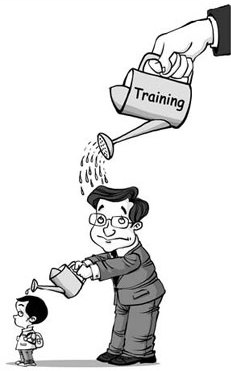Japanese boards must weed out inadequate teachers
The number of teachers recognized by Japanese local boards of education as lacking in ability has been decreasing nationwide for three consecutive years, but this is not news we can accept without anxiety.
Since April 2008, teachers without sufficient ability to manage their classes are required to receive training to boost their skills. To restore public trust in teachers, each board of education must be strict in identifying inadequate teachers and should urge these teachers to retire from teaching or even dismiss them if they show no potential to improve.
According to the Education, Science and Technology Ministry, 371 teachers were evaluated as having inadequate teaching ability in the 2007 academic year by boards of education of prefectures and ordinance-designated major cities, down 79 from the previous academic year.
So far, the definition, criteria and length of training for inadequate teachers have varied by boards of education and the number of these teachers has varied widely. Therefore, the number of such teachers reported each year is seen as just the tip of the iceberg.
The revised Special Regulations concerning Educational Public Service Law, which was enacted in April, stipulates that the length of training for teachers found lacking in ability can last as long as two years. Under the law, boards of education are to judge to what extent these teachers have improved their teaching ability through completing the training and then return them to their posts, transfer them to new positions or dismiss them.
Out with bad, in with good
In February, the ministry created a guideline defining and describing inadequate teachers and giving concrete examples of their shortcomings-erroneous lesson content, refusal to answer students' questions or discuss lessons with students, and other problematic conduct. The ministry should immediately confirm that each board is evaluating teachers based on the ministry's guideline.

About 80 percent of these teachers are in their 40s and 50s. The ministry explains that they stick to the same conventional ways and cannot cope with the changing nature of students and their parents and guardians.
However, there are many cases in which such teachers demonstrate little vocational aptitude or desire to improve. For example, some are unaware that they are causing troubles and instead pass the buck to others. Their writing on the blackboard is a barely readable scrawl and they write kanji characters making strokes in the wrong order.
Against the background of mounting distrust in teachers, a system for renewable teachers licenses initially had been discussed as a way to remove unqualified and inadequate teachers from the classroom. In the end, the system was not aimed at directly removing them.
As an alternative, training to boost their skills and post-training evaluation to determine whether to return them to their jobs, transfer them to a new position or dismiss them were settled on.
Given this, boards must take a stricter stance in identifying inadequate teachers, retraining them and deciding their subsequent fate.
Meanwhile, the number of teachers who were not hired after a one-year trial period, hit a record high of 301 in the 2007 academic year, about triple the number in the 2002 academic year. Were there problems in the employment system itself?
With the series of bribery allegations leveled against the Oita Prefectural Board of Education officials in connection with teacher employment examinations providing a good opportunity, each board of education nationwide has been reviewing employment examinations.
What should boards do in order to accurately discern aptitude and ability as a teacher as well as to carry out a fair examination? They should devise better examinations by conducting follow-up surveys to better compare the results of the written and interview portions of the teacher employment examinations with their later evaluations of teachers that are hired.
The Yomiuri Shimbun/Aisa News Network
(China Daily 10/22/2008 page9)














